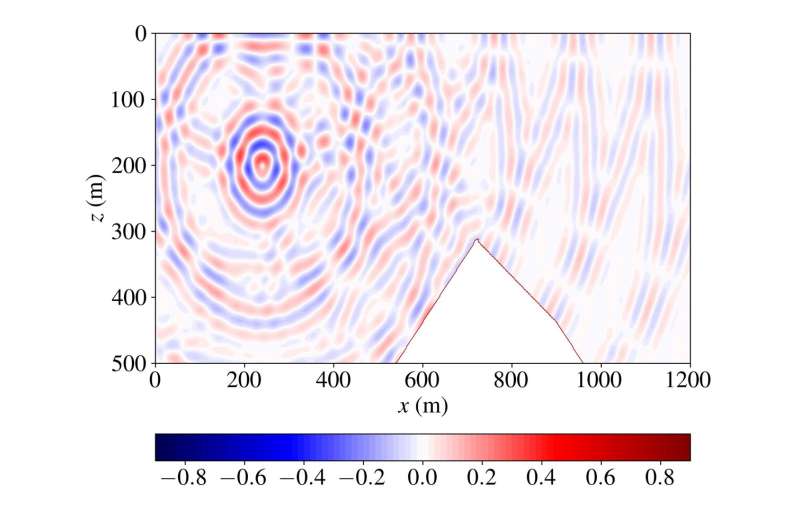This article has been reviewed according to Science X's editorial process and policies. Editors have highlighted the following attributes while ensuring the content's credibility:
fact-checked
peer-reviewed publication
trusted source
proofread
New tech could help reduce ecological impact of underwater noise pollution

A new system that harnesses the power of AI to accurately model how sound waves travel underwater could help reduce the impact of noise pollution on marine life.
Researchers from the University of Glasgow in the U.K. and the University of British Columbia in Canada are behind the development of the technology. In the future, their system could empower industries including shipping and renewables to make better-informed decisions about the effect of their activities on the undersea world.
The loud sounds created by human technologies including the propellers of cargo ships and the construction and operation of offshore wind farms have been shown to have negative effects on a wide range of sea life. The noise can disrupt migration patterns of marine mammals like dolphins and whales and affect their ability to navigate by echolocation.
One potential answer to reducing the impact of underwater noise is developing a more complete understanding of the ways in which sound waves from human activities move and spread through the ocean.
That could help policymakers develop new regulations for shipping and offshore turbine construction to mitigate their impact on surrounding sea life.
Sound waves reflect off the surface of the ocean, the seabed, and everything in between in complex, ever-shifting patterns. As the sound waves move through the water, they also decrease in intensity—a process known as transmission loss.
Accurately modeling the physics of sound wave movements, interactions and transmission loss underwater is currently very difficult without using large amounts of computer processing power. Large-scale projects can take days of computing time to fully model the spread of sound waves through water.
The researchers set out to investigate whether deep neural networks could help tackle the computational challenge, and bring future systems closer to providing real-time feedback on the propagation of sound waves which could be used in the real world.
In a new paper titled "Deep neural network for learning wave scattering and interference of underwater acoustics" and set to be published in the journal Physics of Fluids, the researchers describe how they built and tested their acoustic wave modeling system using a neural network architecture known as a convolutional recurrent autoencoder network, or CRAN.
The CRAN works by compressing very complex, or "high-dimensional," modeling data into more simplified, "low-dimensional" form. Then, a state-of-the-art AI model known as a long short-term memory network analyses the simplified model based on what it has learned previously about underwater physics, producing predictions of how underwater sound waves propagate over time.
Since the system is working from a simplified model and expanding it using machine learning, it can provide results much more quickly than conventional modeling processes.
To train their system, they created 30 different two-dimensional simulations of underwater environments, each with different seafloor surfaces and sound frequencies, to help learn the physics of underwater sound waves.
Once the CRAN was trained, they asked it to predict how the sound waves would behave in 15 new underwater scenarios that the CRAN had never seen before.
It performed the task with remarkable accuracy, correctly predicting how waves interact with each other and are scattered by rigid surfaces. The CRAN model was capable of accurately predicting wave propagation with less than 10% error for a duration more than five times longer than the duration of the data it was trained on.
Dr. Wrik Mallik, of the University of Glasgow's James Watt School of Engineering, is the paper's corresponding author. He said, "These are really encouraging results, which clearly show the potential deep neural networks hold for predicting the complex physics of underwater ocean acoustic propagation.
"Waiting seconds instead of days to produce models of underwater acoustic scattering would be a significant breakthrough for this field of research, and this paper shows how we've taken one step closer to making that happen. Having real-time feedback on devices which could be used out on the ocean would allow much more effective planning to help mitigate the effects of noise pollution on marine animals.
"Although this early-stage study demonstrated the effectiveness of the CRAN on two-dimensional data, we're confident that the technology can be scaled up to meet the challenge of dealing with fully 3D acoustic simulations. We've already begun work to further develop and refine the system, and we plan to test it in real-world situations in the months ahead."
More information: Deep neural network for learning wave scattering and interference of underwater acoustics, Physics of Fluids (2024).
Journal information: Physics of Fluids
Provided by University of Glasgow




















